Alkan Society Bulletin no. 69, April 2005
THE ALKAN SOCIETY
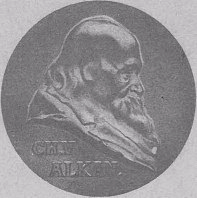
(Registered Charity number 276199)
http://www.alkansociety.org
President: Yonty Solomon
Vice-Presidents: Nicholas King, Hugh Macdonald,
Wilfrid Mellers, Richard Shaw
Secretary: Nicholas King, 42 St. Alban's Hill, Hemel Hempstead, Hertfordshire, HP3 9NG
e-mail: secretary@alkansociety.org
Chairman: Eliot Levin
Treasurer: Averil Kovacs e-mail treasureralksoc@aol.com
Archivist: Brian Doyle Bulletin Editor/Webmaster: David Conway
Bulletin e-mail: info@alkansociety.org
All contents of this Bulletin © The Alkan Society, 2005
BULLETIN no. 69 April 2005
The Society’s New President
Yonty Solomon was unanimously elected as the Society’s new
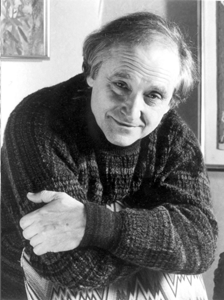
President at the Annual General Meeting on 31st March.
Yonty Solomon has enjoyed a distinguished worldwide career in
recitals, concertos and chamber-music. His extensive repertoire
includes the complete Bach 48 Preludes and Fugues, Goldberg
Variations, all 32 Beethoven Piano Sonatas, the entire piano music
of Ravel, Debussy, Janacek and Ives, as well as a broad spectrum of
romantic and contemporary music.
After graduating with highest distinction in both Music and
Psychology at the University of Cape Town, South Africa, he
continued his studies with Dame Myra Hess, Guido Agosti and
Charles Rosen, winning several major piano competitions, including the Harriet Cohen
Beethoven Medal.
Yonty Solomon has been soloist throughout the world with many of the most important
symphony orchestras. He is a Fellow of the Royal College of Music, where he is currently
Professor of Piano.
We are delighted that this distinguished exponent of romantic keyboard music – whose
powerful rendition of the Bach/Busoni Chaconne made such a memorable conclusion to
year’s celebration in memory of Ronald Smith – has undertaken to serve as the Society’s
President.
- 1 -
Alkan Society Bulletin no. 69, April 2005
The pianist Thomas Wakefield gave a recital of some lesser-known pieces of Alkan following the
Society’s 31st March AGM, and prepared the following notes for the programme, which are followed
by an appreciation of the recital by David Goodrum:
This evening's recital consists of works by Alkan, many of which will be receiving their first
performances in the UK.
Back in the days when the impenetrable mystique surrounding Alkan threatened to engulf even his
first name, one thing a least was certain: he was the 'Berlioz of the piano'.
But how helpful was that sobriquet? For in addition to insinuating that he was not one hundred percent
original (how would Wagner have liked to be called the "Liszt of the opera house"?) there is no doubt
that many of those sensitive souls for whom the little things make the big things, feel alienated and
somewhat alarmed by the distant horizons of these epic works, but respond instantly to the originality
and depth of feeling of the miniatures,
But for most of us, the Concerto, the Symphony and 'Quasi-Faust' were where we came in. It showed
good judgement on the part of the early Alkan pioneers to start with these works. Scintillating and
electrifying, the perfect vehicles for the virtuosity of a Smith or a Lewenthal, they are through -
composed in a homogenous style that immediately places Alkan.
Conversely the disorientation of one let loose among the miniatures must be as complete as that of the
hapless wanderer who on falling foul of some sprite or leprechaun, finds himself transferred to
Amazonian rain forests, where he gapes in wonderment at hitherto unimaginable life forms. Indeed,
some of Alkan's miniatures are so contradictory, so mutually exclusive, one can only fully engage with
one piece by (temporarily) forgetting another. Those chosen for the excellent selection of works in
'Alkan in Miniature' by Ronald Smith (published by Billaudot) ranges from severe asceticism, via rapt
mystical contemplation and the pastoral, to sun drenched Latin exuberance.
Rather than lose our esteemed listeners in a pathless jungle tonight, we have therefore decided on a
connecting thread for our selection, music that reflects Alkan’s fondness for the intellectual discipline
of classical forms and the poignant response it elicited.
In addition to reflecting Alkan's keen sense of musical history, the Handel and Mozart
transcriptions show his razor sharp ear for original timbre and texture and preternatural ability to
conjure them out of the piano.
Alkan’s transcriptions have been described by Delaborde and Phillip as 'more orchestral than Liszt'.
The difference is that Liszt paraphrases a work from the inside outwards; like a great character actor he
lives out the part in a parallel universe to the original character putting core essence before mimicry.
Alkan is like those artists who can instantly evoke a human face from an exact curve of an eyebrow or
those sharp impressionists who mimic each other's acts for good measure. Had he transcribed
movements from the Messiah in its original form, then in Mozart's re-orchestration and then as Liszt
might have done it, we would all know which is which.
Alkan’s stance as an upholder of the great tradition and his antipathy to new fangled compositional
trends stemmed not from narrow mindedness but, like the man who cannot travel far without enduring
home sickness, was triggered purely by his great love and knowledge of those traditions. The Trois
Menuets op. 51 are emblematic of that side of his nature. Perhaps he also thought that this aristocratic
musical form, which had been in favour through Bach's lifetime, had received short shrift recently,
being often side lined in sonata and symphonic music via its snappier cousin the scherzo, which
provided greater contrast with the slow movement. Some famous minuets were written in binary form
- 2 -
Alkan Society Bulletin no. 69, April 2005
but Alkan uses full-scale minuet and trio form, the minuet in ternary form returning after the similarly
constructed trio to provide ternary within ternary. By turn resolute, wistful and jovial, they contain
many interesting cross references.
The Trois Marches quasi da cavalleria op. 37 follow the same form but with more extended codas
in bravura style. All are in essence 6/8 marches but the first and second sport 2/4 signatures with
truth that alongside the decorated war hero's returned poor mutilated wretches, was not lost on Alkan.
After the nightmarish harmonies of the first, the stark resignation of the second and the tormented
chromatic counterpoint of the third, its deliberately hollow, bombastic conclusion is a stroke of
supreme irony.
We hear from contemporary accounts that Alkan could be a delightful companion when he chose, and
his two self-portraits - Ma chère liberté and Ma chère servitude op. 60 confirm rumours of
amiability. They again contain many interesting cross- references.
During an all-Schubert recital by one of the greatest pianists of the day, an American virtuoso buff was
heard to complain - "1 don't dig it, it's all music". Should any of you feel that tonight's programme to
have taken such a turn, deliverance is at hand - the Etude alla-barbaro (which was recently
discovered by Marc-André Hamelin) and the Etude in A minor are both high wire show stoppers of
the type only Alkan and Liszt knew how to write.
Beethoven's 3rd piano concerto is often said to date from 1800, although his habit of keeping
numerous compositional projects on the boil at one time makes it hard to say for sure what was
composed when. Alkan' s motives for transcribing this particular work are somewhat obscure. Most
performers who transcribe do so either to provide themselves with effective repertoire, or to popularise
the music. Yet Alkan was a recluse who seldom played in public, and Beethoven's C minor Concerto
was already well known. In a succession of audacious musical puns the Cadenza's startling references
to an even better known piece which, suffice it to say, is by the same composer, in the same key and
appeared four years later.
The manuscript of Les Regrets de la Nonnette is dated 7th July 1854. It first came to light when it
came up for sale at Sotheby's a few years ago. It was bought by the owner of Symposium Records who
has given permission for it to be performed this evening.
Meyerbeer's opera, Le Prophète, received it premiere at the Paris Opera on 16th April 1849.
Comparing Alkan' s pulverising arrangement of the Overture with his idiomatic treatment of Choeur
des Prêtres de Dagon demonstrates his immense breadth of musical culture and consummate mastery
of the art of the piano transcription.
Thomas Wakefield
----oo00oo----
An appreciative audience of 28 members and guests was treated to a recital of Alkan rarities
performed by Thomas Wakefield after the Annual General Meeting in the Concert Room of the Royal
Academy of Music. Many of the works performed were receiving their first London airing, if not their
first performance worldwide in modern times.
Thomas opened with Choeur des prêtres de Dagon, transcribed from Handel’s Samson by Alkan.
This was a bright and incisive performance. Stylistically, modern ears might feel some of the left hand
octaves to be anachronistic, but the demands on technique were overcome effortlessly. Thomas
followed this with the transcription of Mozart’s motet Ne pulvis et cinis. In effect, this piece
demanded control of a three-handed texture. Its mixture of lyricism and fervour was conveyed with
conviction and authority, and whilst several of those present seemed to find this musically the least
convincing item in the programme, there was no doubting the sincerity of conception or delivery.
- 3 -
Alkan Society Bulletin no. 69, April 2005
There followed the three Menuets of op.51, each a full-scale work in ternary form. Thomas introduced
these by speaking of their wealth of thematic cross-references and compositional ingenuity. The first
two, in particular, contained some harmonic progressions which were startling to those able to identify
them, yet unassailably Alkanesque in their logic: who else, having settled in the leading note key of D,
would find his way back home to E flat by converting a dominant ninth from major to minor
configuration? The third of these, in G, contained sublimely stretched melodies of the type we only
find in Alkan.
Two of the Trois marches quasi da cavalleria, op.37, came next. The programme notes spoke of stark
resignation in the second and tormented, chromatic counterpoint in the third. Both were performed
with careful attention to detail in the inner parts, and more harmonic surprises sustained the interest of
listeners, notably an extended passage in C sharp minor from an opening key of C minor for the third.
The Deux petites pièces of op. 60 were described in the programme notes as self-portraits. Ronald
Smith’s authoritative published study of the works somewhat dismissively describes them as “worth
exploring at a domestic level though a rather thin middle section in the first becomes obsessive and
tiresome”. For once, one is inclined to argue with the great man. The first has more than a trace in it of
J’étais endormie (from op.31), not least in its key and opening motif, whilst the second is again
characterised by intricate harmonic progressions. Both were presented with sensitivity and command.
Thus far, Thomas had felt constrained by recent illness to perform from score. The remainder of the
programme, comprising more familiar fare in his repertoire, was given from memory. The first half of
the concert was concluded by the Etude alla-barbaro and the Etude in A minor, both relatively short
but heavyweight studies of compelling pianism, in the second of which a fearsome series of cat’s
cradles between the hands and repeated notes and chords engrossed those who had taken the
precaution of sitting in view of the keyboard.
The second half of the recital opened with Alkan’s transcription of the first movement of Beethoven’s
Piano Concerto in C minor. As with the Handel which had opened the programme, some aspects of
the transcription might have sounded odd to modern-day ears, though familiarity with the Concerto
from op.39 would have prepared most for the way in which the piano is used to represent both
orchestra and solo parts. Alkan’s cadenza converts the rising scale of C minor which opens the piano
exposition of the movement into the C major scale which characterises the fourth movement of the
later Fifth Symphony, an allusion which was not lost on those present; many other aspects of figuration
were also reminiscent of Alkan’s own Concerto, and may indeed have influenced the way in which he
approached these movements of his minor key studies.
Les Regrets de la Nonnette is a piece which our late President had made particularly his own
following the discovery of the manuscript and its purchase by the owner of Symposium Records, and
has more recently attracted a wider audience through its inclusion in the graded syllabus of one of the
major examining boards, in an edition by our Secretary. Thomas gave this an evocative and thoughtful
reading before launching into his final pièce de resistance, the transcription of the overture from
Meyerbeer’s Le Prophète, which some of us had heard previously at the University of London recital
last September. Even in itself this would have been a remarkable tour de force; that it concluded a
programme of such considerable pianistic demands was all the more amazing, particularly bearing in
mind that Thomas was not in the best of health. In acknowledgement of the generous and deserved
applause at the end of the recital, he gave us a reprise of the A minor Etude to send us on our way
reflecting that if we sought a continuing advocate of the Master’s work following the lamented loss of
our late President, here is a foeman who is more than worthy of his steel.
This introduction to many pieces previously dormant or unperformed was a remarkable experience for
those present, and the Society is hopeful that they may soon be committed to recorded form.
David Goodrum
- 4 -
Alkan Society Bulletin no. 69, April 2005
Rejcha…….and others
I cannot claim to be any sort of authority on the composer Antonín Rejcha but attempting recently to
play through some of his fascinating keyboard compositions I have been unable to resist wondering
about his possible influence on Alkan.
Rejcha was born in Prague in 1770 but moved to Bonn in his teens where he befriended Beethoven.
Beethoven introduced him to the music of Bach, and both were admirers of Haydn. They remained in
contact and Beethoven owned a copy of, and was perhaps influenced by, Rejcha’s 36 Fugues
dedicated to Haydn, written around 1803. Rejcha was very interested in musical and mathematical
theory, claiming that ‘the study of mathematics helps to regulate the fevered imagination’. There is
apparently an unpublished manuscript in German ‘Philophisch-praktische Anmerkungen’, written
about the same time as the fugues. His published writings include treatises on composition and stage-
music, written during his later career in Paris, when he modified his name to Antoine Reicha. He was
appointed professor of counterpoint and fugue at the Conservatoire in 1818 – a year before Alkan
began there as a pupil in solfège - and remained there until his death in 1836, succeeding Boieldieu at
the Académie in 1835. Amongst his pupils were Berlioz, Gounod and Franck. Although Reicha is not
mentioned in Ronald Smith’s Alkan biography, it seems impossible that Alkan cannot have known his
music, or, indeed, the man himself.
Recordings I have of Rejcha’s chamber music and of his ‘Te Deum’ display interesting and well-
constructed work with a nice sense of colour and melody – thoroughly attractive and individual. (It
would be interesting to hear the lost – or perhaps never-written – octet mentioned in his memoirs,
which consisted of a wind quartet in E minor and a string quartet in G major which could be played
separately or simultaneously). But the keyboard pieces I have been looking at – the 36 Fugues and
‘L’Art de Varier’, op. 57, also written around 1803 - often appear seriously wacky.
The op. 57 consists of a theme and 57 variations (could it have inspired Mr. Heinz?), whose layout and
technique often seem to presage early and middle Alkan:



- 5 -
Alkan Society Bulletin no. 69, April 2005

These must surely have been known to the composer of ‘Le Festin d’Esope’.
The 36 fugues (op. 36, of course) also display an unusual approach. Rejcha felt that the old rules of
fugue were too constricting and took a lenient view of consecutive fifths, the key of entry of new
voices, and so on. No. 5 is a ‘rewrite’ of Bach’s G major fugue from book 2 of the 48; no.3 takes its
theme from the slow movement of Haydn’s quartet op. 20 no, 5, no.7 from the opening of Mozart’s
‘Haffner’ symphony. No. 15 alternates bars of 6/8 and 2/8. No. 13, composed according to Rejcha’s
‘new harmonic system’ suggests the world of Alkan’s preludes on plainchant modes:
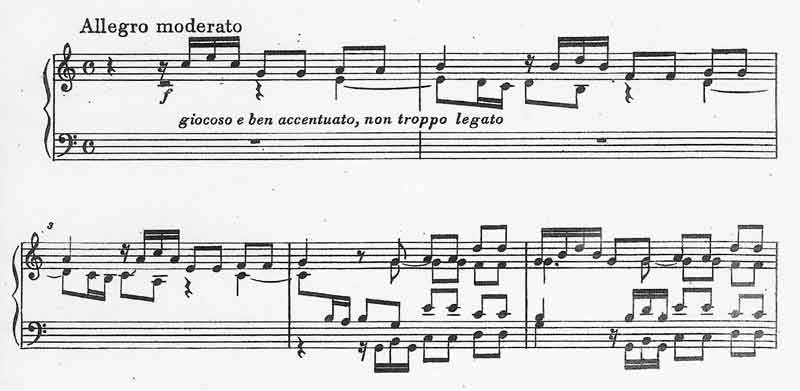
No. 12, which starts in A minor but ends in G, has the following baffling subject and includes, in its
progress, several intervals of silence from one to three bars, anticipating John Cage (give or take 4
minutes 25 seconds).
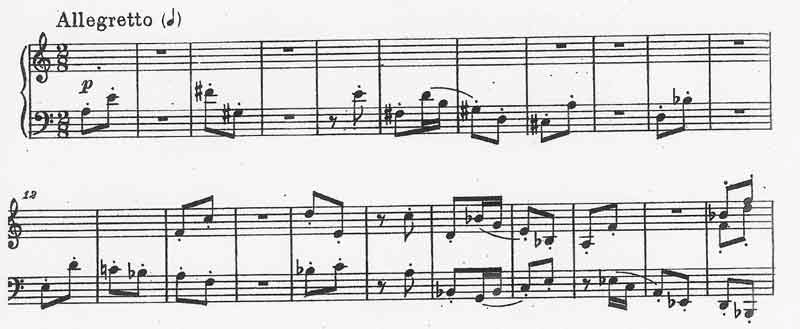
It does not of course detract from Alkan’s originality in any way that other composers of his era also
had original ideas which resulted in fascinating and genuinely musical results. It would be interesting
- 6 -
Alkan Society Bulletin no. 69, April 2005
to hear this and some of the forgotten music of Alkan’s contemporaries and near-contemporaries in a
recital together with his own music so that we can savour the context.
Recently, for example, when listening to the new recording (by Piers Lane, on Hyperion CDA67394)
of Moscheles’s ‘Characteristic Studies’ op. 95, written in 1836/37, I was struck by how close in mood,
harmony and texture many of them were to Alkan’s ‘Chants’ – not perhaps totally surprising given the
influence on both of Mendelssohn. Here are the beginnings of no. 1 (‘Anger’) and no. 6 (‘Bacchanal’).
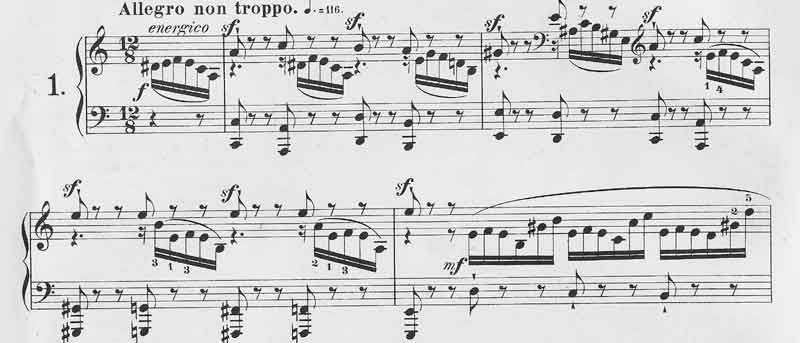
If this is not actually Alkan country, it is very close to the border. Now that Alkanistes have to a great
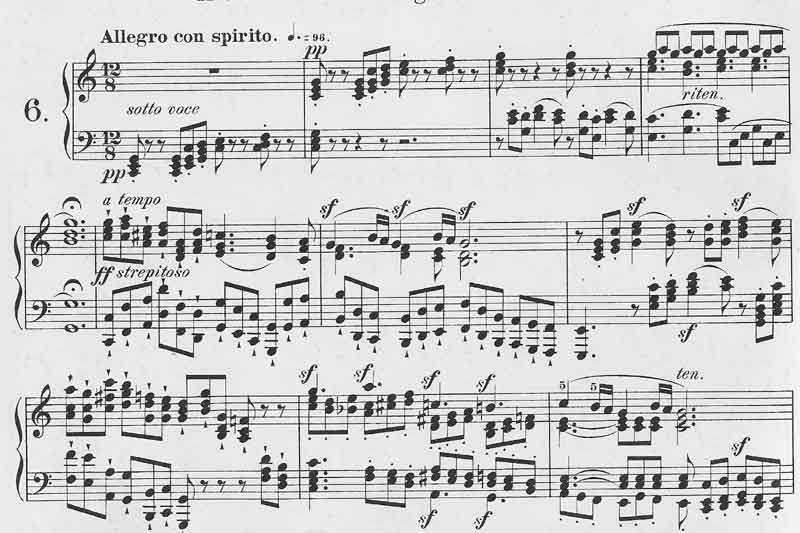
extent succeeded in establishing the recognition of Alkan as a significant composer, it could be
appropriate for us to work more on the links between his music and that of others.
David Conway
- 7 -
Alkan Society Bulletin no. 69, April 2005
Editor’s Notes
• The Society’s venture into CD recording (kindly assisted by Symposium Records),
containing the music played at the celebration of Ronald Smith last year, has been a
success, to the extent that it is now sold out. We seem to have created an instant
collector’s item!
• The world of Alkan recordings seems to have been quiet in recent months, except for
Franck’s version of the ‘Prière’ op. 64 no. 5 appearing on a Christopher Herrick recital
on Hyperion (CDA 67436). However, new excitements are on the way. These will
include a projected complete recording of Alkan’s organ works on 3 CDs by Kevin
Bowyer. He will be including items such as the op. 31 Préludes, normally heard on
piano but for which Alkan provided detailed comments for organ performance, and the
unpublished ‘Pro Organo’. We hope to have an interview with Mr. Bowyer in the next
issue of the Bulletin.
• The Society’s website still attracts regular attention and interest. It also brings in
enquiries about Alkan and information from all over the world. Recent e-mailers have
included a gentleman in Mexico who is making a new orchestral arrangement of the
first ‘Concerto da Camera’, an American enquiring about Alkan’s songs and a
Dutchman with a query on his biography. We hope to continue to develop our
reputation as a major source of Alkan information.
• We also welcome a new web site, that of the pianist John Kersey
(http://www.johnkersey.org). Mr. Kersey provides downloadable mp3s of a number of
Alkan items of great rarity (including the unpublished ‘Palpitamento’) none of which
appear to have been issued yet in commercial recordings. He also provides recordings
of many of Alkan’s contemporaries, including Heller, Leybach and S. S. Wesley. This
is a really valuable resource.
• Slowly but surely, the remainder of the society’s Bulletins are being posted in the
Members’ Section of the website. Only Bulletins nos. 1–26 now remain to be
processed, so there is some hope this can be achieved in the present year. We arte also
hoping to finalise arrangements for posting the remainder of the Bulletins of the
Société Alkan in the near future. Members are reminded that the passwords for the
members’ section will be changed as from May 13th. The new passwords will be
found on the back of the 2005 membership cards being sent with this bulletin. For
those receiving the bulletin by e-mail, membership cards will arrive separately by post.
-----oo00oo----
The Society’s Treasurer mentions that, because it is convenient for the Society to group all
credit card payments together, the subscription for members paying in this format may not
appear on their statements until a little later in the year. We are grateful to all who have added
donations to their subscription payments - thank you!
- 8 -